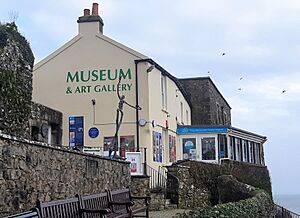Tenby Museum and Art Gallery facts for kids
 |
|
| Established | 1878 |
|---|---|
| Location | Castle Hill, Tenby, Pembrokeshire, Wales |
|
Listed Building – Grade II
|
|
| Official name | Tenby Museum |
| Designated | 19 March 1951 |
| Reference no. | 26353 |
The Tenby Museum and Art Gallery is a cool place to visit in Tenby, Pembrokeshire, South West Wales. It's actually the oldest independent museum in all of Wales! It first opened its doors way back in 1878.
This museum has lots of interesting things to see. You can learn about the local geology (rocks and earth), biology (plants and animals), and archaeological finds (old things dug up from the ground). They also have items related to the sea and ships. Since 1976, the museum has also shown amazing art. You can see paintings and crafts by famous artists like Augustus and Gwen John. The building itself is very old and special, known as a Grade II listed building.
Contents
How the Museum Started
The idea for the Tenby Museum began in January 1878. A group of people who loved history and science met at Charles Allen's home in Tenby. They wanted to create a museum for the town. This group included Edward Laws, Dr. Frederick Dyser, and Rev. George Huntington.
Their main goal was to display a collection of valuable rocks and fossils. These had belonged to Rev. Gilbert N. Smith, who was an amateur archaeologist and geologist. The town of Tenby bought his collection for £100. This collection became the first items in the new museum. The founders decided the museum would only collect things related to the local area. They wanted it to be a museum just for Tenby and its surroundings.
The group found a perfect spot for the museum: an old school building on Castle Hill. In February 1878, the Tenby Town Council agreed to let the museum use the building. They rented it for a very small fee – just one shilling a year! The museum's founders had to pay for all the repairs and running costs themselves.
A local builder named Lewis John fixed up the building. He repaired the roof, windows, and stairs. He also did some plastering and painting. The museum also bought some display cases for their collections. To pay for all this, the founders asked people in the community for help. They sent out letters explaining their plans and asking for donations. Many people supported the idea. For example, E. J. Reed, a Member of Parliament, gave £100.
Museum History and Awards
The museum has grown and changed over the years. On June 17, 1976, the Wilfred Harrison Art Gallery officially opened. Later, in 1995, a New Art Gallery was added to the museum.
In the 20th century, the Tenby Museum became connected with the National Museum and Galleries of Wales. This helped the museum get more recognition and support from other museum groups.
The museum has even won national awards! In the 1990s, it received the Prince of Wales Award in 1993. It also won the Shoestring Award in 1996. This award was for the UK museum that achieved the most with the least money. In 2000, the museum won more awards for its excellent training programs.
On July 31, 2003, Prince Charles (who is now King Charles III) visited the Tenby Museum and Art Gallery. He came to celebrate the museum's 125th anniversary.
People Connected to the Museum
Many interesting people have been involved with the Tenby Museum over the years. Here are a few:
- William Lyons (1776–1849): He lived in Tenby and loved collecting natural history items. His daughters later gave his shell collection to the museum in 1878.
- Dr. Frederick Daniel Dyster (1810–1893): He was one of the museum's founders. He was very interested in sea life and donated many science books to the museum's library.
- Charles Allen (1807–1884): The first meeting to plan the museum was held at his home. He was also a member of the Town Council and served as Mayor of Tenby twice.
- Edward Laws (1837–1913): He was a key person in starting the museum and became its first secretary. Edward Laws was a historian and archaeologist. He wrote several books about the local area.
- Professor George Rolleston (1829–1881): He was a professor at Oxford and helped teach about animals. He worked with Edward Laws on archaeological digs in Tenby in 1877. He also opened the museum on July 26, 1878.
- Edward Rawdon Bingham Power (1811–1896): He moved to Tenby after working in Ceylon. He was a local judge and served as Mayor of Tenby in 1872. He regularly attended museum meetings and supported its work.
What You Can See at the Museum
The museum has many different exhibits for visitors to explore. You can learn about:
- Local history
- Geology (the study of rocks and the Earth)
- Archaeology (the study of human history through digging up old things)
- The history of ships and the sea in the area
- Even piracy!
The New Gallery often changes its exhibits. It shows modern art and crafts made using different materials. The museum also has a permanent art collection. This includes works by famous Welsh artists like Gwen and Augustus John, Kyffin Williams, John Piper, Nina Hamnett, Claudia Williams, John Uzzell Edwards, and John Knapp Fisher.


